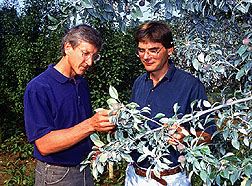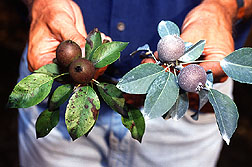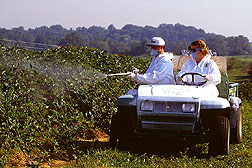Particle Films . . . A New Kind of Plant Protectant
|
|
Microscopic mineral particles may help promote environmental stewardship around the world. Agricultural Research Service and Engelhard Corporation scientists have discovered that films made from these particles repel pests and may deter disease attack when sprayed on plants.
These particles have been specially sized and shaped. Prototypes of this particle film technology called HPF have been successfully field-tested in North America, Europe, and South America.
Products, which will be commercially available in 1999 in parts of the United States for use on apples and pears, will be cost-competitive with conventionally used chemicals.
"Not only can agricultural products made from these particles cut the amount of pesticides needed, they may also boost plant health, aid fruit quality, and over time, improve the condition of the soil," says ARS soil scientist D. Michael Glenn. He heads the project, assisted by entomologist Gary J. Puterka, at the Agricultural Research ServiceAppalachian Fruit Research Station in Kearneysville, West Virginia.
"We've successfully tested HPF technology on several insects and mites and on disease-causing fungi and bacteria," Glenn reports. "It works not only on tree fruit crops, but has potential to work on vegetable and field crops as well."
ARS has signed a cooperative research and development agreement with Engelhard Corporation of Iselin, New Jersey, to develop and commercialize the new technology. The company has filed patents, including foreign patent rights, on the particle technology, with ARS as co-owner. More patents may be forthcoming.
This research shows why USDA joined with the U.S. Environmental Protection Agency (EPA) and Food and Drug Administration (FDA) in 1994 to establish a voluntary partnership with industry to protect human health and preserve the environment by reducing pesticide use and risk.
In this case, industry became involved early on, for it was a particle provided by Engelhard Corporation--one of the largest producers of specialized particles in the world--that first aroused Glenn's interest. As a leader in surface chemistry, Engelhard can modify the size and shape of particles and control the way they are distributed on a particular surface, making it possible to engineer them for specific purposes.
"The films are made of microscopic mineral particles of low toxicity," Glenn says. "Current prototype films are made by modifying kaolin, a naturally occurring mineral that is generally regarded as safe."
In fact, kaolin is approved by the Food and Drug Administration as an indirect food additive. It doesn't harm earthworms or beneficial insects like ladybugs and doesn't affect crop pollination. HPF products made from kaolin should reduce the amount of conventional pesticides needed for crop production. Engelhard produces kaolin commercially for use in many products, including pharmaceuticals, electrical insulators, cosmetics, plastic extenders, paint, and paper. The product is sprayed on as a liquid, which evaporates, leaving a film on the plant or crop surface. Coating plants completely with the liquid is very important. Since the particles are sprayed on crops in a water-based slurry, the material sticks to plant leaves, stems, and fruit, forming a white powdery film. No special equipment is needed for application; traditional spraying equipment can be used.
Does this coating interfere with photosynthesis?
|
|
"Just the opposite," Glenn explains. "The properties of the particles are such that sunlight diffuses into leaves, resulting in little reduction of light."
What's more, the reflective nature of the particles reduces heat stress on leaves and lowers the temperature in a tree or plant canopy. As a result, fruit will often have better color, higher soluble solids, reduced internal breakdown, and increased weight.
The particle application may also indirectly enrich the soil. While some pesticides reduce earthworm populations, this material allows them to move freely through soil, funneling organic matter down from the surface and making tunnels that increase water infiltration and aeration. Improved soil structure created by earthworms aids plant growth and productivity.
According to Puterka, particle technology works to deter insects and mites in several ways. "The particle film coats the plant, forming a protective barrier," he says. "When insects come in contact with film-coated plants, tiny particles from the coating attach to their bodies, agitating and repelling them.
"Even if the particles don't attach to their bodies, the insects still find the environment unsuitable," Puterka reports. "Nonflying insects that are unable to leave the plant thus become confused and disoriented when the particles attach to them. The pests are unable to feed or lay eggs."
Another deterrent for insects, he says, is that the white, highly reflective particle coating makes the plant unrecognizable as a host. This may be similar to the concept of whitewashes, which have been shown to repel certain insects, such as aphids.
Which Pests and Diseases Are Thwarted?
For several growing seasons, Glenn and Puterka have tested the particles on a broad range of insect pests and diseases on apple and pear trees. The treatment was effective against leafhoppers, leafminers, spirea aphids, thrips, European red mites, two-spotted spider mites, and late-season apple diseases such as sooty blotch and flyspeck.
"We also had high suppression rates for the plum curculio and codling moth but haven't yet reached economic levels of control," Puterka says. "Our most spectacular success with the particle films to date has been controlling arthropod pests and diseases of pears. We've been able to fully control pear psylla and pear rust mite and to suppress fabrea leaf spot--major problems for pear growers."
According to Puterka, the particles may be most applicable on crops that will end up being washed and waxed, like tree fruits, peppers, and cucumbers; or on root crops like peanuts, potatoes, and sweetpotatoes. This, he says, is because the white film left on leaf, stem, and fruit can be either allowed to weather off or removed after harvest. Conventional packinghouse equipment removes the film.
ARS and Engelhard field-tested particle films in 1997 and 1998 on apples, peaches, and pears in Chile. "We did the tests in Chile while it was winter here in the United States. Results were very successful," says Puterka.
In one trial, several sections of an abandoned pear orchard were selected for particle film spraying. "At the end of the season, we went back to check progress and were amazed. Treated groups of trees stood out in the orchard like tiny oases in a desert," says Glenn.
"Trees in treated areas were green and flourishing, while those in untreated areas were starkly different: sparse foliage, small leaves, and little new growth. And the pears we gathered from the treated areas were the first harvested from that orchard in 7 years. There was no fruit on the trees that had not been sprayed with the particle mixture."
In other Chilean studies, treated peach trees yielded 50 percent more fruit, while treated apple trees maintained their yield.
|
|
In tests on tree crops in Italy, particle spray increased color in pears. But it didn't completely stop aphids in apples, peaches, or pears, nor the third generation of codling moths. Nevertheless, Glenn says, the Italian tests were successful, overall. Fine tuning the spray timings could improve control.
Treatment on apples in Kearneysville orchards increased tree vigor, which allowed trees to support more fruit and increased production. When applied to a newly established peach orchard, the treatment even controlled Japanese beetles. Glenn says this is an indication that the particle film would work well for the nursery industry, giving young trees a chance to get a head start on growth by preventing insect attack, while reducing water stress.
Results were confirmed in collaborative studies at ARS' Yakima Fruit and Vegetable Research Station horticulture research station at Wapato, Washington. There, particle-sprayed apple and pear orchards showed increased fruit size, red color, and leaf photosynthesis, along with cooler canopy temperatures.
These research results were confirmed at six different fruit-growing regions in 1998. Fine tuning the spray program increased efficacy and reduced the number of sprayings needed.
Growers Try It and Like It
Both conventional and organic growers are excited about their field-test results with the particle films.
Grower Eric Rice of Middletown, Maryland, says, "The particle film worked better than the crop protection methods we were using. Although I'm impressed with what the particle film did on my crops, one of the major advantages this technology has over conventional chemicals is the aspect of grower/worker safety.
"A farmer is exposed to whatever he applies to his crops. This particle film comes from inert mineral deposits, and we know that the FDA regards it as safe. This means a lot to growers," he says.
Rice's acreage includes apples, pears, berries, vegetables, flowers, and a cow/calf/hay operation.
"I sprayed my apple trees with the mixture, and it suppressed the codling moth and plum curculio, which are major pests, and worked on leafrollers," says Rice. "We don't have much trouble with mites, aphids, and other insects, probably because we use beneficial predatory insects."
Results were more variable for disease control, he says.
"The spray was completely effective for fire blight, although 1997 might have been a year of low incidence. Under organic guidelines, we can spray streptomycin on fire blight, but even then, we always get a little infection. With the particles, we didn't have a single incident of fire blight."
However, the new treatment didn't work as well with apple scab the first year. Trees not susceptible--or with average susceptibility--to scab, fared well. But for gala apple, which is highly susceptible to the disease, the particles didn't provide protection.
"I must say that our spray schedule in 1997 for the galas was probably not properly targeted. We didn't spray until after full bloom, and we got infection on the fruit. But since there was no infection on the leaves, we know that the material must have provided some measure of control," Rice reports. Adjusting the spray schedule in 1998 brought excellent results.
The Washington Tree Fruit Research Commission--a grower-funded organization that is a research partner in the venture--is testing the products in commercial apple orchards.
"We are interested in these products for their insect- and disease-control potential, but primarily for their horticultural benefits," says James McFerson, a scientist with the Commission. "We're evaluating the products, which we applied with typical airblast sprayers, on three 1-acre, replicated test plots."
Ray Schmitten grows pears on 120 acres in the Wenatchee River Valley of Washington.
"We sprayed our orchards with kaolin products this spring and got complete control of pear psylla, our biggest pest problem," he says. "We used no other products for this pest."
Pear psylla deposit honeydew on leaves. But in areas where the new products were used, there was no evidence of this sticky substance. For pear psylla, the products worked better than conventional pesticides.
Schmitten says the products also completely controlled rust mite and were effective on codling moth, although it was still early in the season for this pest. Another unexpected benefit, he says, was that the kaolin products reduced the effect of a fine fuzz that pear leaves produce, which causes field workers to cough.
EPA Exempts Particle Film
In 1997, EPA granted an experimental use permit for Engelhard and ARS to field-test the material with 50 collaborators--including other ARS and university scientists, as well as growers--throughout the United States. The mineral particles have been approved for use on organic farms in Virginia, Maryland, and Washington. Because the product is chemically inert and low in toxicity, EPA exempted the particle film technology from pesticide tolerance regulations and on March 17, 1998, registered three prototype products for use.
"It takes about 8 years for a new pesticide to go through the EPA registration process," says John Mosko, marketing manager for Engelhard. "But with help from USDA, we dramatically stepped up the trial program for these products after we saw such promising early results. This will help us launch particle film products commercially in 1999.
"We're not touting these particle films as a replacement for chemical use. But we realize that growers need alternatives to chemicals, especially those that may have difficulty in getting re-registered by EPA," he says.
Minor Crops Have a Major Need
The new Food Quality Protection Act of 1996 sets a higher standard for conventional pesticides, encouraging development of reduced-risk products. Many so-called minor-use pesticides may soon no longer be available to growers. Potential registrants will not seek re-registration if there is insufficient economic incentive to justify data requirements or if new regulations require them to cut back some uses. Minor-use pesticides are applied to such crops as fruits, vegetables, nuts, ornamentals, and nursery products.
Grown on 8 million acres in the United States, minor crops are valued at around $24 billion annually. This is about 40 percent of all agricultural crop sales. "Growers of these crops are going to be hurting for alternatives to chemicals that may not be available in a few years," Mosko says. "Our new particle technology can help fill this void."
"We're fortunate that Engelhard is our partner in this venture to further develop new technologies from these mineral particles," says Glenn. "This technology can help us realize our goal of having 75 percent of U.S. agricultural acreage under integrated pest management programs by the year 2000."--By Doris Stanley, Agricultural Research Service Information Staff.
D. Michael Glenn and Gary J. Puterka are at the USDA-ARS Appalachian Fruit Research Station, 45 Wiltshire Rd., Kearneysville, WV 25430-9423; fax (304) 728-2340. [Glenn] phone (304) 725-3451, ext. 321, and [Puterka] phone (304) 725-3451, ext. 361.
"Particle Films . . . A New Kind of Plant Protectant" was published in the November 1998 issue of Agricultural Research magazine. Click here to see this issue's table of contents.









